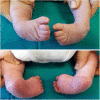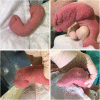What a paediatrician should know about congenital clubfoot
- PMID: 32498693
- PMCID: PMC7271518
- DOI: 10.1186/s13052-020-00842-3
What a paediatrician should know about congenital clubfoot
Abstract
Clubfoot is the most frequent congenital malformation of the foot, affecting more than 1-2 subjects per 1.000 newborns. Without appropriate treatment, a child with congenital clubfoot will never be able to walk physiologically with a dramatic impact on the quality of life. In the last decades, different corrective solutions have been proposed, and there is rising scientific evidence that the Ponseti non-invasive method is safe and effective in the treatment of the clubfoot. So, what should a general paediatrician know about this condition and what should he concretely do in the suspect of a congenital clubfoot?
Keywords: Clubfoot; Equinovarus; Management; Pediatric; Talipes.
Conflict of interest statement
The authors declare that they have no competing interests.
Figures




References
MeSH terms
LinkOut - more resources
Full Text Sources

